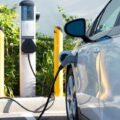
Appetite among drivers for electric vehicles (EVs) is waning amid rising living costs and surging energy prices, according to new research from Auto Trader.
Electric vehicles represented over a quarter (27%) of the share of new car enquiries being sent to retailers through Auto Trader’s marketplace in June, when petrol reached almost £2 a litre. But by November, as energy prices rose and fuel prices softened, EVs accounted for less than one in five (19%) of enquiries, according to the latest edition of Auto Trader’s Road to 2030 Report.
The report also reveals that, for the first time since the start of the pandemic, year-on-year (YoY) demand for used EVs is in decline with a double-digit (12.6%) slide in the past 12 months as wider market dynamics, coupled with consumer fears over rocketing electricity bills, throw Government ambitions for the electrification of the UK automotive industry off course.
As demand softens, the stock of used EVs has been building in recent months as previous years’ new cars enter the second-hand car market. Stock levels have doubled from 10,600 in at the start of 2021 to 20,600 in Q3 2022. Ordinarily this growth would be greeted as good news enabling more used cars buyers to make the transition to EVs, but it’s coincided with the demand dip with the supply of used EVs overtaking demand for the first time.
The report also underlines fundamental barriers to EV adoption such as the lack of choice and affordability. And with five times fewer new electric models (17) than ICE under £30,000 (the £20,000 – £30,000 price bracket is the most popular on Auto Trader) the majority of EVs are out of reach for all but the most affluent car buyer.
A used EV still costs circa £10,000 more than an equivalent petrol or diesel vehicle, whilst a brand-new model is still over a third (36%) more expensive, an increase from 31% at the start of 2022 and an alarming move in the wrong direction away from a vital price parity point between EVs and their petrol or diesel equivalents.
These market factors have therefore pushed back Auto Trader’s forecasts for when EVs will account for 50% of new car sales from 2026 to 2027. With an expectation that around 90% of sales will be fully battery electric vehicles by 2030 (with the remaining new cars being hybrid vehicles), meaning that the later stages of the UK’s road to electrification are going to be particularly steep.
Despite the high upfront cost and despite the energy context being less favourable than it has been, running costs are still in favour of EVs with owners saving on average £124 per 1,000 miles on running costs compared to an internal combustion engine (ICE) vehicle. Even if the Government energy guarantee were totally removed in April 2023, EVs would still be cheaper per 1,000 miles, with the comparative saving dropping to £80 per 1,000 miles.
Erin Baker, Editorial Director at Auto Trader commented: “Although current sales figures look positive, the rapid decline in consumer appetite for electric vehicles reveals the market is on thin ice where mass electric adoption is concerned. And with the forecast of new car electric sales reaching 50% being pushed back to 2027 the market faces a precarious combination of factors which could cause major potholes on the road to 2030 without further action from government and industry to encourage mass adoption.
“There are some positive signs with running costs still in EVs favour, and more affordable models in the pipeline, particularly those from Asia. But today’s slowdown in demand for EVs translate into lower sales as we enter 2023.”









